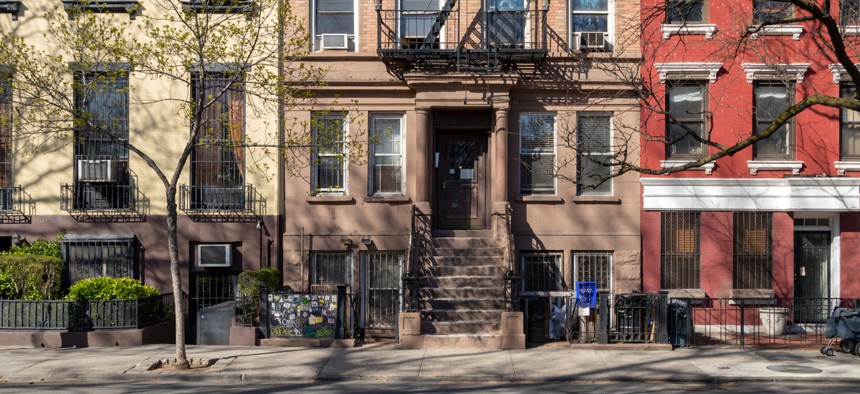The High Cost of a Looming Eviction Wave

Housing advocates fear a wave of evictions if more money isn't directed towards rental assistance programs. Shutterstock
With millions of people behind on rent, there could be a lot of evictions this winter. A new report suggests the cost of these evictions on the social safety net could be astronomical.
The economic fallout of the Covid-19 pandemic has already had a big impact on the renters, with nearly 16% of the country’s 43 million tenants behind on their rent in October. One in four renters have no or slight confidence they can pay their rent on time next month, and another quarter is only moderately confident they can do so.
Without another stimulus package providing renters with a direct infusion of cash or allocating money to local rent relief programs, housing advocates say they are worried that renters’ situations could grow more dire in winter months and lead to a wave of evictions. This is especially true if local or federal eviction moratoriums expire.
Recent estimates found that between 6.7 million and 13.9 million households could be at risk of eviction. If 25% of newly evicted people become homeless, the costs to public health and social safety net programs would be astronomical—between $62 billion and $129 billion, according to a new report from the National Low Income Housing Coalition and the Innovation for Justice program at the University of Arizona.
The hefty price includes the cost estimates for running programs that newly homeless people interact with, such as emergency shelters, inpatient medical care at hospitals, emergency medical care, foster care, and juvenile delinquency programs.
“In addition to the cruelty of throwing people out of their homes during a pandemic, a wave of evictions would create significant downstream costs for public health and social service systems,” said Diane Yentel, NLIHC president and CEO.
The report noted a previous estimate that renters could owe as much as $29 billion in back rent by the end of January.
Like many recent housing studies, the study found that Black and Latino households, along with those where renters earn less than $25,000 annually and those that have experienced a loss of income since the onset of the pandemic in March, are more likely to be behind on rent and at risk of eviction.
One of the largest costs of an eviction wave would be the need to expand emergency shelter capacity, as some renters who are evicted won’t be able to temporarily move in with family or friends during the pandemic. Covid-19 eviction-related emergency shelter costs could range from $27 billion to $56 billion, the report estimated.
Researchers estimate that 32% of evicted household members who become homeless will need emergency medical care, to the tune of $8 billion to $18 billion, and 23% will need inpatient medical care, costing up to $29 billion. Most of this care would be due to conditions directly related to homelessness.
A September executive order placed a moratorium on evictions for most renters through the end of the year. The order, issued by the Centers for Disease Control and Prevention and the U.S. Department of Health and Human Services, bars landlords from evicting tenants in federally backed housing and those making less than $99,000 per year, or $198,000 if filing jointly. In order to gain the order’s protections, renters have to certify that they have “used best efforts” to pay and would likely become homeless if faced with eviction. The order does not cover people in motels, hotels, and other temporary housing situations that became common havens for people evicted in the early days of the pandemic.
Even with the federal moratorium in place, many renters are still facing eviction—and when it ends on Dec. 31, millions could be at risk of losing their homes.
Landlords have chafed at the extension of moratoriums, saying they need to be paired with financial assistance so that property owners can pay their own bills, like making mortgage payments.
A recent analysis by the Urban Institute found that small landlords—those who own fewer than 10 properties—described increasing pressure this fall as more tenants fell behind on rent. Many reported tightening their screening criteria for new tenants or were looking to sell, which could drive up rents if institutional owners take over.
An October analysis by the Federal Reserve Bank of Philadelphia came up with a smaller, but still substantial, estimate of people behind on rent. The Fed found that 1.3 million households will owe $7.2 billion in unpaid rent by the end of 2020. A disproportionate amount of that debt will fall on Black and Hispanic families, as well as households headed by single women.
The researchers in Philadelphia noted that while the federal eviction moratorium has certainly helped keep some renters in their homes, “this stopgap measure has left millions of additional households, many owing thousands of dollars of back rent, at risk when the moratorium expires.”
"These households are primarily those with workers who lost jobs yet did not receive state or federal unemployment insurance (and other associated CARES Act provisions)," the report reads.
Both the report from the Philadelphia Federal Reserve and the report from the National Low Income Housing Coalition and Innovation for Justice conclude that state and local governments need more funding to enact protections for renters—and they need it fast. Researchers believe that much of the looming costs of an eviction wave could be avoided by an infusion of cash into rental assistance programs, direct stimulus money, and unemployment assistance, as well as a renewed federal moratorium on evictions for non-payment of rent.
“We are approaching a very dark winter,” said Mackenzie Pish, the program manager at Innovation for Justice. “Without intervention directed at housing stability and rental debt, a surge of evictions, displacement, and homelessness is imminent.”
Emma Coleman is the assistant editor for Route Fifty.
NEXT STORY: States’ Face-Covering Mandates Leave Gaps in Protection






